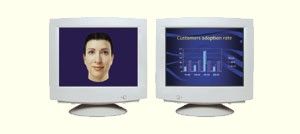Matrox Launches The G550
The G550 Positioning Conundrum
Matrox is faced with a very difficult proposition when it comes to positioning the G550. The main problem with the G550 is that it doesn't go head-to-head with the competition from Nvidia and ATI in any category, unless you count dual-screen or 2D acceleration. Yet, it tries to force the issue on 3D by bundling software that is designed to, as the company's marketing blurb says, "introduce cutting edge 3D to the home Internet and corporate desktop markets for the first time." Cutting edge 3D technology in this case means venturing into the unknown territory of VOC, an uncharted segment of the market, as we will find out.
This is the only real criticism I have with the G550: while the emphasis on performance, and value in the graphics market is defined primarily by 3D functionality, Matrox has opted to focus on one 3D function of the G550, HeadCasting, and given it the starring role, despite not having a strong case for justifying this approach.
To quote the company's own marketing blurb, "The Matrox G550 is the first graphics chip to use 3D technology to improve and enrich online communication, spurring a new form of online exchange called Visual Online Communication (VOC)."
The definitiion of VOC is given in three applications: corporate training, customer relationship management (CRM), and visual messaging. In each case, Matrox assumes that first, we live in a world that is primarily connected to the Internet by 56K modems, and secondly, there is a benefit to enhancing online communications using a 3D facial model with lip synching.
For PowerPoint, Matrox demonstrates the full benefit of a G550 board using the dual screen set-up with one screen showing the 3D facial model of the presenter talking through the slide show on the second screen. The image below shows this application in action.

Matrox's G550 allows you to create and distribute PowerPoint presentations in conjunction with an animated, lip synched, 3D facial representation, even on low bandwidth connections, or just as a demonstration in dual screen mode. It's a nice effect, but is it practical?
Stay on the Cutting Edge
Join the experts who read Tom's Hardware for the inside track on enthusiast PC tech news — and have for over 25 years. We'll send breaking news and in-depth reviews of CPUs, GPUs, AI, maker hardware and more straight to your inbox.
Current page: The G550 Positioning Conundrum
Prev Page Introduction Next Page The G550 Positioning Conundrum, ContinuedMost Popular

